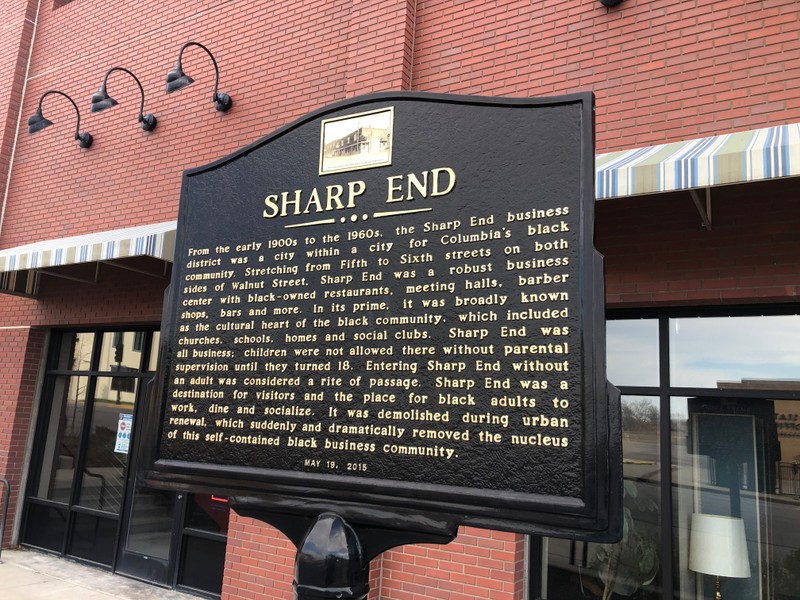Sharp End Historical Marker
Introduction
Text-to-speech Audio
This historical marker was dedicated in 2015 and commemorates a predominantly African-American business district called Sharp End that grew in the early 1900s and was taken over by the city in a series of urban renewal projects in the early 1960s. The district was located on both sides of Walnut Street between 5th and 6th Streets and featured many restaurants, barbershops, clubs, and other businesses. Apartments and a church were also located here. Sharp End developed in the early 1900s and was one of the few areas in the city where Black residents were allowed to operate businesses because of rampant discrimination, a factor that also limited opportunities for Black consumers in other parts of the city. The only building that remains of Sharp End is a brick structure on the southwestern corner of 5th and Walnut.
Images
This historical marker commemorating Sharp End was erected in 2015.

Backstory and Context
Text-to-speech Audio
Sharp End's transformation into a business district for the African-American community began around the early 1900s. At the time, the city's business district, known as Market Square, was located here. However, the area was prone to flooding from the Flat Branch creek so the city decided to move Market Square to its current downtown location on 8th and 9th streets. The move opened up the area for Black residents and it became one of the few areas in the city in which they were allowed to live, open businesses, shop, dine, and gather. By 1910, Sharp End had established itself as the city's commercial and cultural center for the African American community.
Despite Sharp End's centrality to many residents, the city showed little regard for the area, which was known as the Douglas neighborhood. The city failed to maintain roads, provide basic services to most residents, and, until the 1930s, dumped garbage in the Flat Branch Creek, which was also filled with human and livestock waste. And because of widespread discrimination and limited opportunities, many Black residents were stuck in a cycle of poverty in small wood-frame homes that lacked plumbing or electricity. The city's neglect of the area was intentional and reflects the pervasive racism against Black residents in Columbia during the early 20th century.
It was the cumulative effect of this indifference, however, that compelled the city to embark on its urban renewal project in the 1950s. In 1949, Congress passed the Federal Housing Act, which granted funds to communities around the country for the purpose of acquiring blighted areas through purchase or eminent domain. The poverty and blight of the Flat Branch area were a direct consequence of the city's decades of neglect. In 1956, the city designated 126 acres in the area to be taken by eminent domain. Federal and state law required property owners to be fully compensated but this was not the case for the Black residents and business owners. The city paid just over half of the $1 million that was estimated to be fair value for the 126 acres. The second round of urban renewal began in 1959, and it saw the removal of hundreds of buildings, including 80 Black businesses. Many residents were not eligible for public housing built in the neighborhood, nor were they allowed to get home loans to buy houses in mostly white areas. As a result, urban renewal displaced Black residents and prevented many of them from generating wealth through homeownership.
The historical marker was installed in 2015 by the Sharp End Heritage Committee, the Economic Development Inc., and the City of Columbia. It is one of several markers of the African American Heritage Trail.
Cite This Entry
M., Ben and Clio Admin. "Sharp End Historical Marker." Clio: Your Guide to History. April 26, 2022. Accessed March 31, 2025. https://theclio.com/tour/879/15
Sources
Hart, Jessica. "Remembering the Sharp End business district in downtown Columbia." KRCG. February 24, 2021. https://krcgtv.com/news/local/remembering-the-sharp-end-business-district.
Hart, Jessica. "Urban renewal dismantled the Sharp End, a Black business district in the 20th century." KRCG. February 25, 2021. https://krcgtv.com/news/local/urban-renewal-dismantled-the-sharp-end-a-Black-business-district-in-the-20th-century.
Houser, Pamela & Paggiarino. "Last building in historic Sharp End District a reminder of its legacy." Columbia Missourian. December 19, 2017. https://www.columbiamissourian.com/news/local/last-building-in-historic-sharp-end-district-a-reminder-of-its-legacy/article_05c1ce98-e201-11e7-a689-274cdd9b6ae7.html.
"Sharp End." The Historical Marker Database. Accessed April 21, 2022. https://www.hmdb.org/m.asp?m=169437.
Thomas, James M. "Sharp End: The Sorrid History of Race, Space, and Inequality in Columbia, Missouri." November 13, 2015. https://jamesmichaelthomas.wordpress.com/2015/11/13/sharp-end-the-sorrid-history-of-race-space-and-inequality-in-columbia-missouri/#_ftnref1.
The Historical Marker Database

